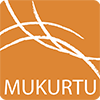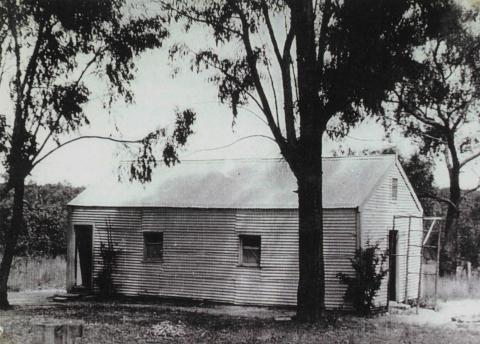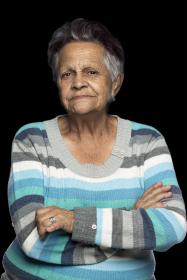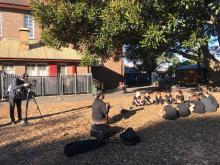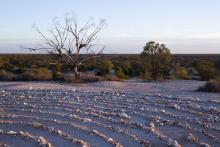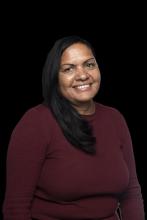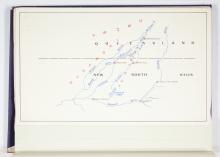Central Western Plains: Burra Bee Dee Mission
The story of Mary Jane Cain and the beginning of Burra Bee Dee is quite a different one to the usual story of Aboriginal people being forced onto reserves and missions and governed by the Aborigines Protection Board. In Mary Jane's case, she claimed the land on behalf of her family. And people came from all around the district when they heard that she had made a reserve for the Aboriginal people.
Mary Jane Cain was born in 1844, on a property at Ulamambri known as "Toorawandi". Mary Jane Cain died in Coonabarabran in 1929, at the age of 85, and her remains now lie at home in the Burra Bee Dee Cemetery.
I, myself, had never had the privilege of meeting or knowing this beautiful lady, my great-grandmother ... because she died 11 years before I was born. Mary Jane's mother was Jinnie Griffin, who was a full-blooded Aboriginal woman, who was brought up in the Mudgee area by a family known as Cox. She died at the camp near Parker's Paddock in 1882.Her dad, Eugene Griffin, was an Irishman that had been sent out to Australia as a convict for stealing a shirt. In her own writings, Mary Jane describes how her parents married at Muswellbrook and travelled between the Mudgee and Coonabarabran districts when they became travelling hawkers.
Jinnie and Eugene Griffin then spent a considerable part of their lives working on the stations and properties in the Coonabarabran district. She describes her father at one stage as "a dairy man who attended the farm, "which grew wheat and tobacco." And her mother as "engaged in shepherding". They had been working on “Toorawandi, the place where Mary was born, for some years in 1844, when Mary Jane was born. And, in her youth, Mary Jane followed the occupation of a shepherd, and thus engaged in and mastered the art of reading, mainly from the study of her prayer book and old newspapers that she was able to gather together. She had a natural determination for reading, which, in later years, turned to verse and novels, as well as ordinary news and political writings.
Mary Jane met and married George Cain, and they lived up on the Gunnedah Hill first of all, then went from there down to a place called Honeysuckle Point. Mary Jane and George decided to move out to Forked Mountain to live. They had nine children, five girls - Queenie, Minnie, Ellen, Liza and Jane - and four boys - Eugene, George, Charlie and Tommy.
Then, in June 1893, at the age of 49, Mary Jane wrote a letter to Queen Victoria. She says that at the time of writing she has nine children and considerable responsibility. Her husband is ill and she is responsible for the support of her children on the land. She and George had cleared some land in preparation for farming and are building themselves a hut. They are having trouble with invasions from neighbouring stock and she asks that their land be measured and fenced. She also requests written proof of their ownership - title and rights to the land. In this letter, Mary Jane Cain bases her claims on her status as the only Aboriginal person from the area and on her motherhood. She writes that she has already complained to the local sergeant and that she has written to the government without response.
Forked Mountain Station, comprising 400 acres, was gazetted on the 6th of February 1892. The letter of 1893 was one of a series of political actions on behalf of her people, that she continued to make throughout the rest of her life. As a result of her continuing political activism over the next 20 years, their land increased to nearly 600 acres, and the many people who came to live there enjoyed a superior standard of life and services.
The time that that happened in 1892, things changed, because the Aboriginal Protection Board did come here after the 1909 Protection Act came out. And other people, other Aboriginal people had come here to Burra Bee Dee to live here with Mary Jane Cain.
Burra Bee Dee means "flying mice". That's the totem of Burra Bee Dee.
The mission manager's house was so very different to our houses. They had bedrooms, they had a bathroom, they had everything. Our home was a four-room home. And this was supposed to be new Housing Commission homes, you know, that sort of thing. One room had a fire, a wood-burning fire stove, right? That was the kitchen and dining room all together. The room just over from that was the boys' room - one room. It had a hallway that came out onto a verandah and the two rooms in the front - the front room this side was the girls' room, the other side was our lounge room. And so, Mum and Dad had to sleep on the verandah. This is where the bathroom would have been, here, around this size. Just out here. This is where we had our swing. It was our play area. Yeah, well... This could've been our pram baby, eh?
It has been a wonderful place to live, but when we left in 1954 ... In 1956, there was some other Aboriginal people living here, then in 1956, they sold the mission. They sold every home that existed here on this mission, including our home. And they went to a property out along the Yaminbah Creek, 18 miles out. They are still there to this day and age. They are still there - being used as storage sheds. And trying to get them back is an horrific thing. It means the world to us. This place here is going to be here forever, and it's going to be here so our young people can share this knowledge, come here and visit a place that is home. I feel a home to all Aboriginal people, because of Mary Jane Cain.
Yalu.


